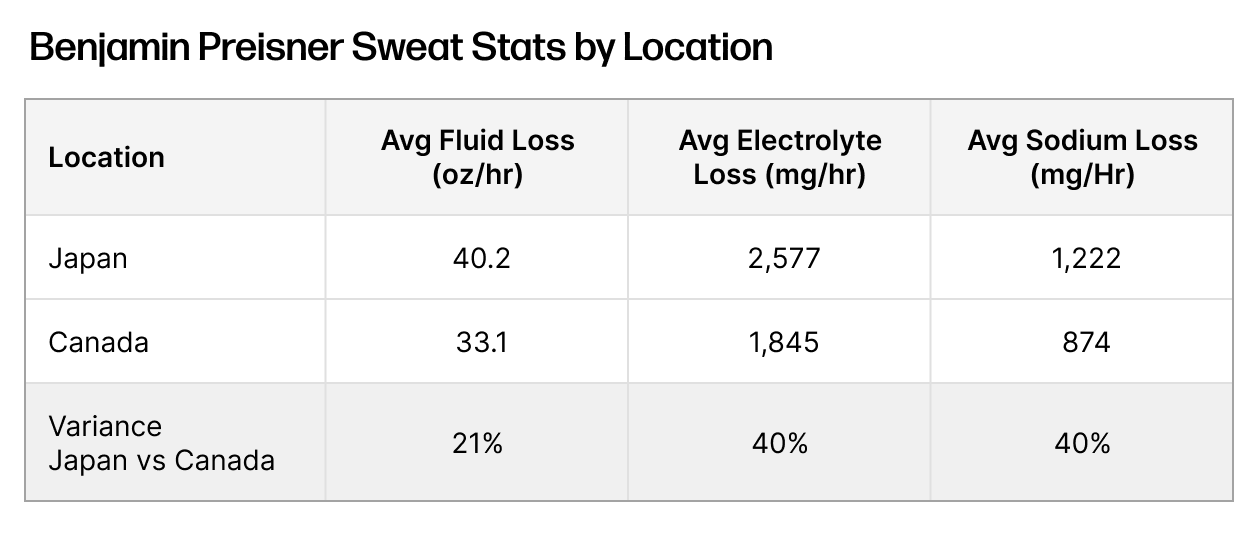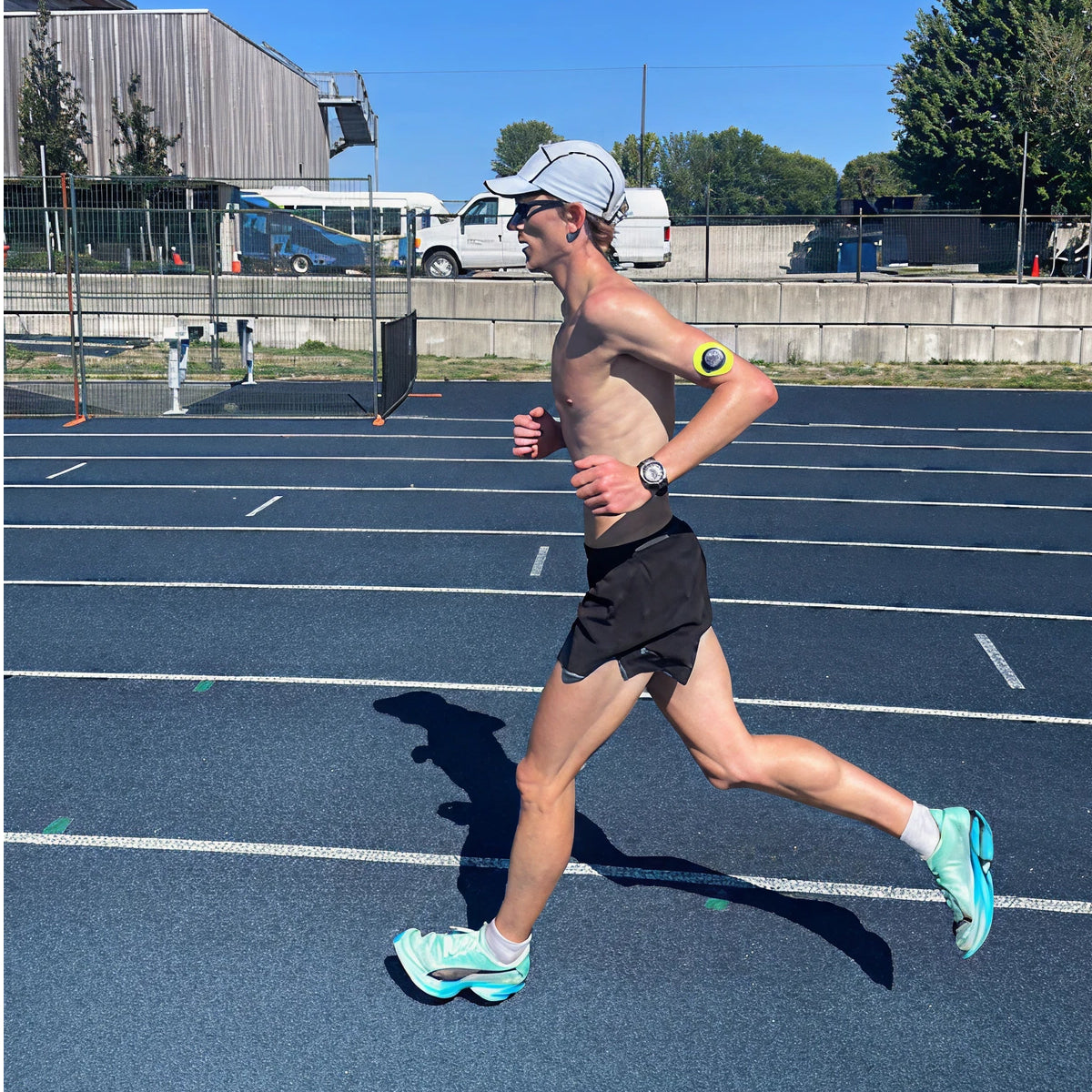Benjamin Preisner’s story is one of balance—between his career as a machine learning engineer in Vancouver, BC, and his place among the fastest marathoners in Canadian history. With a personal best of 2:08:58, he is the third-fastest Canadian marathoner ever. He has already represented his country on the world stage 13 times, including at the 2020 Tokyo Olympic Games and three World Athletics Championships.
But what sets him apart isn’t just his racing credentials—it’s his scientific, data-driven approach to training and hydration.
From Ontario to the Olympic Stage
Preisner first fell in love with running during high school in Ontario, quickly rising to represent Canada at the 2013 World Youth Track and Field Championships. After competing in the NCAA Division I circuit for the University of Tulsa, he knew the marathon was his natural next step.
“I was moderately successful in the longer track distances, but the marathon felt like the event where I could continue to grow,” he says.
In his debut marathon, he ran under the Olympic standard and earned a spot in Tokyo for his second-ever marathon.
Why Hydration Is the Hidden Variable
For marathoners, hydration is one of the most influential yet least understood performance variables. Even mild dehydration—losing just 2% of body weight in fluid—can impair endurance, cognitive sharpness, and heat regulation. For Preisner, this margin can mean the difference between finishing strong or fading in the final miles.
For Preisner, who currently resides in Vancouver, his typical marathon training includes approximately 12 runs (120 miles) per week with his weekly long run including a specific marathon pace built into the training regimen. This volume tapers significantly in the weeks leading up to race day. Preisner also incorporates strength training twice per week along with two active mobility sessions per week (i.e. drills, active stretching).
When discussing his philosophy and approach to training, Preisner notes "I was able to test out the biosensor during the last few weeks of my peak volume training and then the taper into the race. The results from the sweat tests help me in two main ways: 1) to understand my sweat rate and guide how much fluid I need to take during a race, and 2) to understand how much fluid I need to replenish post run/workout for proper recovery (I typically strive for 1.5x the amount of fluid I lost and 1x the amount of electrolytes I lost). The goal is to remove as many unknowns as possible.”
In the past, removing the unknowns came down to doing nude weigh-ins before and after training blocks, measuring his fluid intake, and estimating total sweat losses. With Nix, this process becomes significantly more accessible and much less tedious.
How Nix Data Informed a New Hydration Strategy
Benjamin discovered Nix while looking for an easier and more precise way to measure his sweat loss. “The Nix system is particularly useful if I’m looking for analytics outside of Vancouver—whether that’s a training camp or a race abroad,” he says.
Ahead of the 2025 World Athletics Championships—where temperatures hit 30°C (85°F) with over 80% humidity—Benjamin used Nix during a two-week camp in Japan. The device tracked his fluid and electrolyte losses in real time, producing personalized data tailored to the exact climate he would face.
“It was very beneficial to know what my average sweat rate was in the exact environment I’d be racing in.”
Preisner learned that compared to his home training conditions, Japan’s extreme environmental conditions resulted in a drastically different sweat profile and would require him to make key adjustments to his hydration strategy. On an hourly basis, Preisner lost 21% more fluids and 40% more electrolytes in Japan versus his home training environment in Canada.

Drilling in and identifying these precise and critical differences is crucial to overall performance. Underhydrating will lead to the onset of dehydration risks early on and performance will deteriorate quickly. Overhydrating with water without properly balancing it with electrolytes will lead to hyponatremia. With Nix, Benjamin was able to map his hydration plan directly to his body’s needs and avoid the guesswork. Specifically, Preisner focused on using his Nix Hydration Biosensor to better understand his sweat and electrolyte loss rates and guide the volume and type of fluids he would need to take during a race. Secondly, he found the Recovery Calculator within Nix Solo was a tool that provided guidance for ideal replenishment after his workouts to ensure proper rehydration and recovery. His rule of thumb was to strive for 1.5x the amount of fluids lost and 1x the amount of electrolytes lost which matches the calculation that the Recovery Calculator output gives to a user.
At the 2025 World Athletic Championships in Tokyo, Japan, Preisner finished 36th with a time of 2:17:32. Preisner acknowledged that despite his preparations and executing his strategy decently, the hot and humid marathon reinforced that he still has more work to do, specifically ensuring he can persevere in the final few miles while racing in an extreme environment such as Tokyo.
The Science Beyond the Numbers
The Nix Hydration Biosensor works by analyzing the chemical composition, or osmolality, of an athlete’s sweat in real time. It tracks both fluid losses and electrolyte concentration, the two key drivers of hydration balance. For Preisner, this meant understanding not just how much he was sweating, but also the composition of what he was losing—information that directly shapes hydration decisions particularly around electrolyte formulas.
Preisner’s focus on electrolytes revolved mostly around ensuring he was replenishing enough during training and was fully recovered going into the next day’s training. “This was a particular focus for this marathon build because I was using a sauna frequently, on top of outdoor training to heat acclimate. The use of electrolytes in-race (outside of what I get in my fueling/carbohydrates) is definitely something I’d like to explore further, as it could be something to help prevent the bonk that I experienced at the end.”
These insights extend beyond just race day. Post-session data allows Benjamin to adjust training recovery, adapt fluid intake with weather shifts, and refine strategies for future marathons. “The access athletes have to objective data can be invaluable,” he says. “But the key is using it. Too often, athletes collect great information that never actually informs their training or racing.”
Looking Ahead for Preisner
Benjamin is now targeting shorter road races—half marathons and below—before building toward a spring marathon where cooler conditions will provide the chance to chase speed.
With environmental conditions aside, Benjamin’s approach will remain the same: blend personal experience with science, passion, and precision while gaining valuable insights from Nix along the way.
Future Plans:
“I’m looking forward to a spring marathon—one where the conditions are more conducive to running fast.”
Benjamin Presiner






